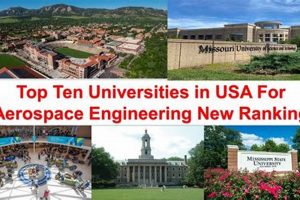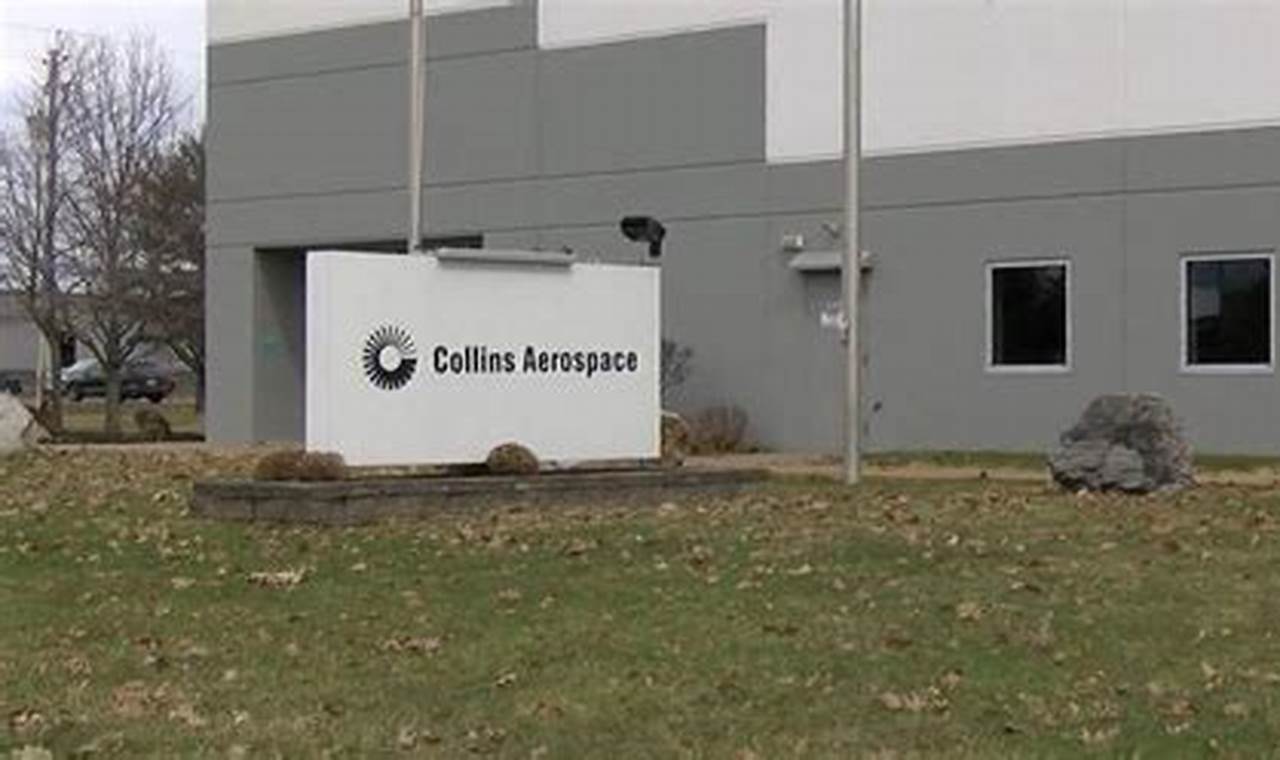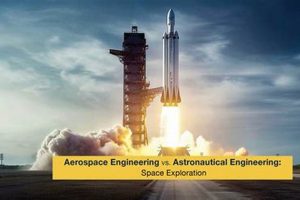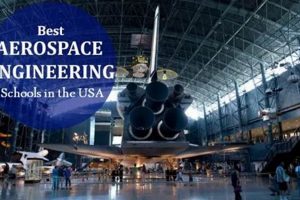One field focuses primarily on the design, development, and maintenance of aircraft that operate within Earth’s atmosphere. This discipline concerns itself with aerodynamics, propulsion systems, structural integrity, and control systems tailored for atmospheric flight. Examples include commercial airliners, helicopters, and general aviation aircraft.
The other is a broader field that encompasses both atmospheric and space flight. It deals with the design, construction, and study of vehicles and technology operating in space, as well as within the atmosphere. Its importance stems from enabling advancements in space exploration, satellite technology, and missile systems, and historically, its development has been driven by both scientific curiosity and national defense concerns.
While both disciplines share fundamental principles of engineering and physics, the distinction lies in their scope of application. Understanding the specific areas of focus, educational paths, and career opportunities within each domain is crucial for aspiring engineers.
Key Considerations for Aspiring Engineers
Careful consideration of career aspirations and academic interests is essential when choosing between these related engineering fields. Each path offers unique challenges and opportunities.
Tip 1: Evaluate Career Goals. Determine if your primary interest lies in aircraft design and atmospheric flight, or if you are drawn to space exploration and related technologies. This self-assessment will guide your academic choices.
Tip 2: Review Curriculum Differences. Aeronautical engineering curricula typically emphasize aerodynamics, aircraft structures, and propulsion. Aerospace engineering programs often include coursework in orbital mechanics, spacecraft design, and satellite communications.
Tip 3: Explore Research Opportunities. Investigate research labs and projects at universities of interest. The availability of specialized facilities and faculty expertise can significantly impact your learning experience.
Tip 4: Consider Internship Experiences. Seek internships at companies specializing in either aircraft manufacturing or space systems. Practical experience provides valuable insights into the realities of each field.
Tip 5: Analyze Industry Trends. Stay informed about the evolving landscape of both industries. Emerging technologies and market demands can influence career paths and specialization areas.
Tip 6: Assess Personal Aptitude. Evaluate your strengths in mathematics, physics, and problem-solving. Both fields require a strong foundation in these areas, but the application of these skills may differ.
Tip 7: Network with Professionals. Attend industry conferences and connect with engineers working in both aeronautical and aerospace fields. Gaining firsthand perspectives can aid in informed decision-making.
In summary, informed decision-making based on self-assessment, curriculum review, and industry awareness is crucial for selecting the engineering path that best aligns with individual goals and aptitudes.
The subsequent sections will delve into the career opportunities and long-term prospects within each domain.
1. Atmospheric Vehicles
The design and engineering of atmospheric vehicles constitute a primary differentiating factor between aeronautical and aerospace engineering disciplines. The focus on flight within Earth’s atmosphere defines the scope and expertise required in each field.
- Aerodynamic Optimization
Aeronautical engineering emphasizes the optimization of aerodynamic performance for vehicles operating in the atmosphere. This includes airfoil design, lift and drag reduction, and stability control. Real-world examples include the development of high-lift wings for commercial airliners and efficient rotor systems for helicopters, demonstrating how aeronautical engineers prioritize atmospheric flight characteristics.
- Propulsion Systems for Air-Breathing Engines
Aeronautical engineers specialize in air-breathing propulsion systems such as turbojets, turbofans, and propellers. These engines rely on atmospheric oxygen for combustion, necessitating expertise in airflow management and combustion efficiency. Examples include the design of fuel-efficient jet engines for long-range aircraft and advanced combustion technologies for reducing emissions, highlighting the focus on propulsion within the atmosphere.
- Structural Integrity in Atmospheric Conditions
Aeronautical engineering requires expertise in ensuring structural integrity under the stresses of atmospheric flight. This includes considerations for aerodynamic loads, atmospheric pressure changes, and temperature variations. Examples include designing aircraft fuselages that withstand extreme pressure differentials and developing materials resistant to fatigue from repeated flight cycles, showcasing the emphasis on atmospheric conditions.
- Control Systems for Atmospheric Flight
Aeronautical engineers develop and implement control systems for maneuvering and stabilizing atmospheric vehicles. This involves designing flight control surfaces, autopilot systems, and navigation technologies. Examples include developing advanced flight control algorithms for fly-by-wire systems and implementing GPS-based navigation for precise aerial maneuvers, highlighting the focus on atmospheric navigation and control.
The concentration on aerodynamic optimization, air-breathing propulsion, structural integrity in atmospheric conditions, and control systems for atmospheric flight directly distinguishes aeronautical engineering from its aerospace counterpart. While aerospace engineering encompasses these considerations, it broadens its scope to include the complexities of spaceflight, a domain outside the exclusive purview of atmospheric vehicles.
2. Spacecraft Focus
The distinct emphasis on spacecraft design, construction, and operation serves as a primary differentiator between aeronautical and aerospace engineering. This focus necessitates specialized knowledge and skills beyond the scope of atmospheric flight.
- Orbital Mechanics and Trajectory Design
Aerospace engineers specializing in spacecraft are proficient in orbital mechanics, the study of the motion of objects in space. This includes calculating trajectories for spacecraft missions, accounting for gravitational forces and optimizing fuel consumption. For instance, planning a trajectory to Mars requires precise calculations to ensure the spacecraft arrives at the correct location at the desired time, showcasing the importance of orbital mechanics in spacecraft missions.
- Spacecraft Propulsion Systems
Spacecraft propulsion systems operate in the vacuum of space and often rely on technologies distinct from air-breathing engines. These systems include chemical rockets, ion thrusters, and solar sails. Developing a propulsion system for deep-space exploration demands expertise in propellant management, thrust vectoring, and long-duration operation, underscoring the unique challenges of spacecraft propulsion.
- Spacecraft Thermal Control
Maintaining temperature within acceptable limits is critical for spacecraft components operating in the extreme temperature variations of space. Thermal control systems utilize radiators, insulation, and heaters to regulate temperature. Designing a thermal control system for a satellite orbiting Earth requires detailed modeling of heat transfer and careful selection of materials, highlighting the importance of thermal management in spacecraft design.
- Satellite Communication Systems
Spacecraft rely on communication systems to transmit data to and from Earth. Aerospace engineers design and implement these systems, considering factors such as signal strength, bandwidth, and interference. Ensuring reliable communication with a spacecraft millions of miles away requires advanced signal processing techniques and robust error correction codes, demonstrating the complexity of spacecraft communication systems.
These considerationsorbital mechanics, specialized propulsion, thermal control, and communication systemsdistinguish spacecraft engineering from aeronautical engineering. While an aeronautical engineer focuses on flight within the atmosphere, an aerospace engineer designs for the unique challenges and demands of the space environment.
3. Aerodynamics Specialization
Aerodynamics, the study of air in motion and its interaction with solid objects, constitutes a critical area of specialization differentiating aeronautical and aerospace engineering. While both fields require a foundational understanding of aerodynamics, the depth and application of this knowledge vary significantly based on their respective domains.
- Atmospheric Flight Optimization
Aeronautical engineering prioritizes aerodynamic optimization for vehicles operating within Earth’s atmosphere. This involves designing airfoils, wings, and fuselages to maximize lift, minimize drag, and enhance stability. The development of advanced wing designs for commercial airliners, aimed at reducing fuel consumption and improving flight performance, exemplifies this specialization. The focus remains on efficient and stable flight within atmospheric conditions.
- Hypersonic Aerodynamics
Aerospace engineering, particularly in the context of reentry vehicles and high-speed aircraft, necessitates expertise in hypersonic aerodynamics. This encompasses understanding airflow at speeds exceeding Mach 5, where phenomena such as shock waves and extreme heating become dominant. The design of heat shields for spacecraft returning from orbit requires a thorough understanding of hypersonic flow to protect the vehicle from intense thermal loads. This highlights the extension of aerodynamic principles to extreme conditions beyond typical atmospheric flight.
- Computational Fluid Dynamics (CFD)
Both disciplines rely heavily on Computational Fluid Dynamics (CFD) to simulate and analyze airflow around complex geometries. However, the complexity of the models and the specific phenomena being investigated often differ. Aeronautical engineers might use CFD to optimize the shape of an aircraft wing, while aerospace engineers could employ it to model the plume impingement of a rocket engine on a spacecraft structure. The tools are similar, but the application and scale of the simulations vary considerably.
- Wind Tunnel Testing
Wind tunnel testing provides experimental validation of aerodynamic designs. While both aeronautical and aerospace engineers utilize wind tunnels, the testing conditions and objectives may differ. Aeronautical engineers might conduct low-speed wind tunnel tests to measure lift and drag characteristics of a new airfoil, while aerospace engineers could perform high-speed tests to simulate the conditions encountered during rocket launch or atmospheric reentry. The purpose of testing is tailored to the specific flight regime of interest.
In summary, aerodynamics specialization highlights a crucial divergence between aeronautical and aerospace engineering. While aeronautical engineering emphasizes atmospheric flight optimization, aerospace engineering extends aerodynamic principles to encompass hypersonic conditions and spacecraft applications. Both fields leverage tools like CFD and wind tunnels, but the specific applications and objectives reflect their distinct domains.
4. Orbital Mechanics
Orbital mechanics, also known as astrodynamics, represents a core competency distinguishing aerospace engineering from aeronautical engineering. It is the study of the motion of artificial satellites and other celestial bodies under the influence of gravity, a domain largely irrelevant to atmospheric flight. This expertise is paramount for designing space missions, controlling satellite orbits, and ensuring the success of space exploration endeavors. This expertise is less relevant to aeronautical engineering.
- Trajectory Design and Optimization
Orbital mechanics provides the foundation for designing efficient trajectories for spacecraft missions. This involves calculating the required velocity changes (delta-v) for transferring between orbits, rendezvous maneuvers, and interplanetary travel. For instance, planning a mission to Mars requires optimizing the trajectory to minimize fuel consumption and transit time, a task requiring deep knowledge of orbital mechanics principles. An aeronautical engineer would rarely require this knowledge
- Orbital Perturbations and Stability Analysis
Real-world orbits are subject to perturbations from various sources, including the Earth’s non-spherical shape, atmospheric drag, and gravitational influences from the Sun and Moon. Orbital mechanics provides the tools for analyzing these perturbations and predicting their effects on satellite orbits. Understanding these effects is crucial for maintaining the desired orbit and ensuring the long-term stability of satellite missions. Aeronautical Engineers, do not typically deal with these pertubations.
- Satellite Orbit Determination and Control
Precise knowledge of a satellite’s orbit is essential for various applications, including navigation, communication, and remote sensing. Orbital mechanics provides the basis for determining satellite orbits from tracking data and implementing control maneuvers to maintain the desired orbital position. For example, GPS satellites rely on accurate orbit determination to provide precise positioning information to users on Earth. This is more relevant to Aerospace engineering jobs.
- Space Debris Mitigation
The growing population of space debris poses a significant threat to operational satellites. Orbital mechanics is used to model the motion of space debris and develop strategies for mitigating the risk of collisions. This includes designing spacecraft trajectories to avoid debris and developing technologies for removing debris from orbit. This is a focus more relevant to aerospace engineering.
The understanding and application of orbital mechanics exemplify a key divergence between aerospace and aeronautical engineering. While aeronautical engineers concentrate on atmospheric flight and aerodynamic principles, aerospace engineers extend their expertise to encompass the complexities of orbital motion and space mission design. The mastery of orbital mechanics is, therefore, a hallmark of aerospace engineering and a critical enabler of space exploration and utilization.
5. Aircraft Systems
The design, integration, and maintenance of aircraft systems are central to aeronautical engineering and constitute a significant point of divergence from aerospace engineering. While both disciplines require a general understanding of system-level engineering, aeronautical engineering places a greater emphasis on the specific systems that enable and sustain flight within Earth’s atmosphere. These systems include, but are not limited to, avionics, flight controls, hydraulic systems, electrical power generation and distribution, environmental control, and landing gear. The complexity and interdependency of these systems necessitate a highly specialized knowledge base. For example, the development of an advanced fly-by-wire system requires expertise in aerodynamics, control theory, and software engineering, as well as a deep understanding of how these elements interact within the broader aircraft system architecture. A commercial aircraft’s safety and efficiency are directly attributable to the performance and reliability of these integrated systems. The systems typically must meet FAA safety regulations. A good example is how aeronautical engineers working for boeing or airbus must be familiar with electrical power distribution across all aircraft sub-systems.
Aerospace engineering, while not disregarding aircraft systems, broadens its scope to encompass the systems required for spacecraft and space missions. This includes propulsion systems optimized for vacuum operation, thermal control systems designed for extreme temperature variations, and communication systems capable of transmitting data over vast distances. Furthermore, aerospace engineers are often involved in designing systems that enable spacecraft to operate autonomously in the harsh environment of space. A practical example of the difference is the development of a satellite’s attitude control system, which relies on reaction wheels, thrusters, and sensors to maintain the spacecraft’s orientation. While certain principles of system engineering are transferable between aircraft and spacecraft, the specific technologies and operational requirements are distinctly different.
In summary, the emphasis on aircraft systems represents a critical distinction. Aeronautical engineering prioritizes the design, integration, and maintenance of systems tailored for atmospheric flight, while aerospace engineering expands its focus to include the unique challenges of spacecraft systems and space missions. This difference in scope necessitates specialized knowledge and expertise, shaping the career paths and technical contributions of engineers in each field.
6. Satellite technology
Satellite technology exemplifies a key point of divergence between aeronautical and aerospace engineering. While aeronautical engineering concentrates on flight within Earth’s atmosphere, aerospace engineering extends to the design, construction, and operation of spacecraft, including satellites, that function in the space environment. The development and deployment of satellites necessitate expertise in areas such as orbital mechanics, spacecraft propulsion, thermal management in vacuum, and communication systems designed for long-distance transmissiondomains largely outside the scope of traditional aeronautical engineering. For instance, the design of a satellite’s solar panels, crucial for power generation, requires consideration of radiation exposure and thermal cycling in space, factors not pertinent to aircraft operating within the atmosphere.
The practical significance of satellite technology further underscores this distinction. Satellites enable a wide array of applications, including communication, navigation, Earth observation, and scientific research. GPS satellites, for example, provide precise positioning data for navigation systems worldwide, while Earth observation satellites monitor climate change and natural disasters. The development and operation of these systems necessitate a deep understanding of space-specific challenges and technologies. This understanding is often applied during the spacecraft testing phase, such as using vibration and thermal vacuum testing to simulate the launch and space environment.
In essence, satellite technology is a defining characteristic of aerospace engineering, setting it apart from aeronautical engineering’s focus on atmospheric flight. The successful development and utilization of satellites demand a comprehensive understanding of orbital mechanics, space environment interactions, and spacecraft systems, highlighting the distinct expertise required in the aerospace domain. This distinct expertise translates into vastly different training and career paths.
7. Materials science
Materials science is intrinsically linked to both aeronautical and aerospace engineering, influencing design, performance, and longevity of vehicles operating within Earth’s atmosphere and in space. While both disciplines rely on advancements in materials, the specific requirements and operating environments necessitate distinct material selection and application strategies.
- Atmospheric Flight vs. Space Environment
Aeronautical engineering primarily focuses on materials optimized for atmospheric conditions. These materials must withstand aerodynamic stress, varying temperatures, and potential corrosion from atmospheric elements. Aluminum alloys, titanium, and composite materials are commonly used in aircraft construction to balance strength, weight, and cost. In contrast, aerospace engineering requires materials capable of withstanding the extreme conditions of space, including vacuum, radiation exposure, and extreme temperature fluctuations. Materials like high-temperature alloys, radiation-shielding polymers, and specialized composites are crucial for spacecraft components.
- Aerodynamic Heating vs. Thermal Cycling
Aeronautical engineering considers aerodynamic heating at high speeds, particularly for supersonic or hypersonic aircraft. Materials with high-temperature resistance and effective thermal management properties are essential to prevent structural failure. Aerospace engineering deals with thermal cycling due to exposure to direct sunlight and shadow in space. Materials must maintain their properties through repeated temperature changes, preventing fatigue and degradation. Examples include heat-resistant tiles on the space shuttle and specialized coatings on satellites.
- Corrosion Resistance vs. Radiation Shielding
Aircraft operating in marine environments are susceptible to corrosion, necessitating the use of corrosion-resistant materials and protective coatings. Aerospace vehicles require materials that provide radiation shielding to protect sensitive electronic components and astronauts from harmful radiation in space. Aluminum and specialized polymers are used for this purpose. The materials science considerations related to mitigating environmental effects are distinctly different.
- Weight Optimization in Atmospheric vs. Space Flight
Weight optimization is critical in both disciplines, but the implications differ. In aeronautical engineering, minimizing weight improves fuel efficiency and payload capacity. In aerospace engineering, weight reduction directly impacts the cost and feasibility of launching payloads into orbit. Lightweight composites and advanced alloys are essential for both applications, but the emphasis on launch cost in aerospace engineering drives the development of ultra-lightweight materials.
The selection and application of materials in aeronautical and aerospace engineering reflect the unique challenges posed by their respective operating environments. While both fields benefit from advancements in materials science, the specific demands of atmospheric flight and space exploration necessitate tailored material solutions and design considerations.
Frequently Asked Questions
This section addresses common inquiries and clarifies misconceptions surrounding the differences between aeronautical and aerospace engineering. The information provided aims to offer a comprehensive understanding of each discipline’s scope and focus.
Question 1: Is aerospace engineering simply a more advanced version of aeronautical engineering?
No. Aerospace engineering is a broader field encompassing both aeronautical engineering (atmospheric flight) and astronautical engineering (spaceflight). While some overlap exists, aerospace engineering is not merely an extension but rather a superset of aeronautical engineering.
Question 2: Can an aeronautical engineer work on spacecraft?
While possible, it is less common. An aeronautical engineer’s expertise is primarily in atmospheric flight. Transitioning to spacecraft-related roles typically requires additional education or specialized training in areas such as orbital mechanics, spacecraft propulsion, and thermal management in a vacuum.
Question 3: Which field offers better job prospects, aeronautical or aerospace engineering?
Job prospects vary depending on industry trends and geographic location. Both fields offer viable career paths. Aerospace engineering may provide access to a wider range of opportunities, including those in the space sector, but aeronautical engineering remains relevant in aircraft design, manufacturing, and maintenance.
Question 4: Do both fields require the same foundational knowledge?
Yes, both require a strong foundation in mathematics, physics, and engineering principles. However, the emphasis shifts depending on the specialization. Aeronautical engineering emphasizes aerodynamics, while aerospace engineering includes orbital mechanics and spacecraft design.
Question 5: Is it possible to switch between aeronautical and aerospace engineering careers?
Yes, career transitions are possible, particularly early in one’s career. However, such transitions typically require targeted training or further education to acquire the necessary skills and knowledge for the new role.
Question 6: Which degree is more versatile, aeronautical or aerospace engineering?
Aerospace engineering is generally considered more versatile due to its broader scope. Graduates with an aerospace engineering degree can pursue careers in both atmospheric and space-related fields, while aeronautical engineers are primarily focused on atmospheric flight. However, some aerospace jobs are highly specialized.
In summary, while both fields are interconnected, they represent distinct areas of specialization with unique challenges and opportunities. Understanding these differences is crucial for informed career planning.
The subsequent section explores the educational pathways and curriculum differences in greater detail.
Concluding Remarks
The preceding analysis clarifies what is difference between aeronautical engineering and aerospace engineering, outlining the distinct specializations within each field. Aeronautical engineering concentrates on atmospheric flight, encompassing aircraft design, aerodynamics, and propulsion systems optimized for the Earth’s atmosphere. Aerospace engineering, a broader discipline, extends beyond atmospheric flight to include spacecraft design, orbital mechanics, and systems engineering for space missions. The key differentiators encompass scope, specialization, and the environmental conditions under consideration.
The selection of either aeronautical or aerospace engineering as a career path warrants careful consideration of individual interests, aptitudes, and long-term professional goals. While both disciplines contribute significantly to the advancement of flight and space exploration, a clear understanding of their respective focuses is essential for informed decision-making. Further exploration into specific areas of interest within each field is encouraged to ensure a fulfilling and impactful career trajectory.







![Top Aerospace Engineering Colleges in Florida [2024] Innovating the Future of Flight with Reliable Aviation Solutions Top Aerospace Engineering Colleges in Florida [2024] | Innovating the Future of Flight with Reliable Aviation Solutions](https://mixaerospace.com/wp-content/uploads/2025/12/th-913-300x200.jpg)